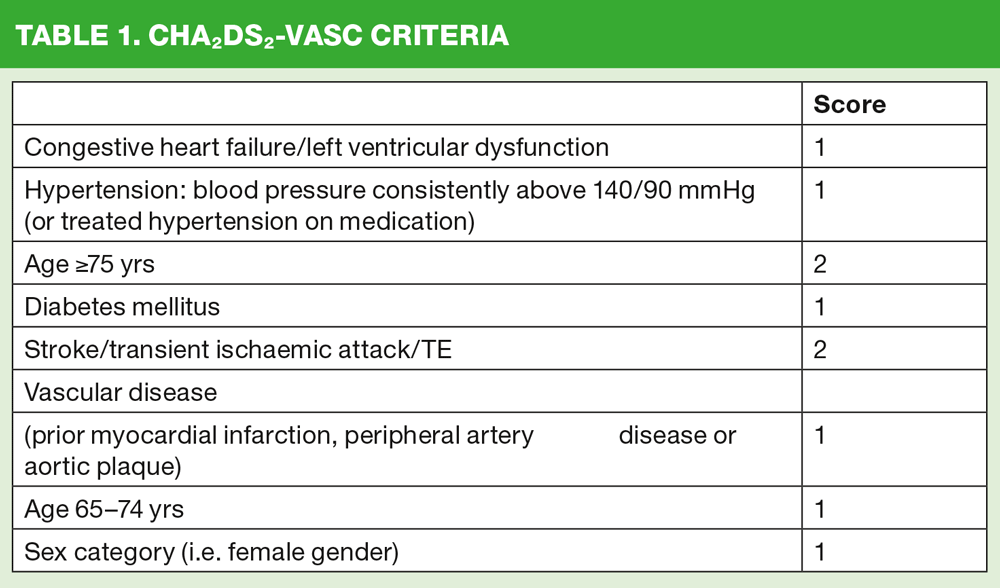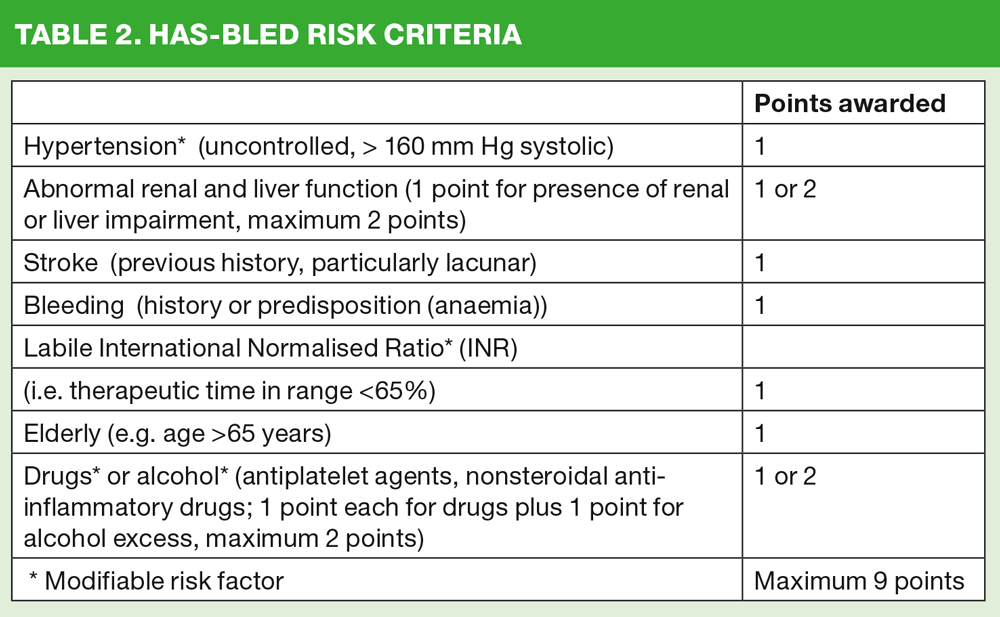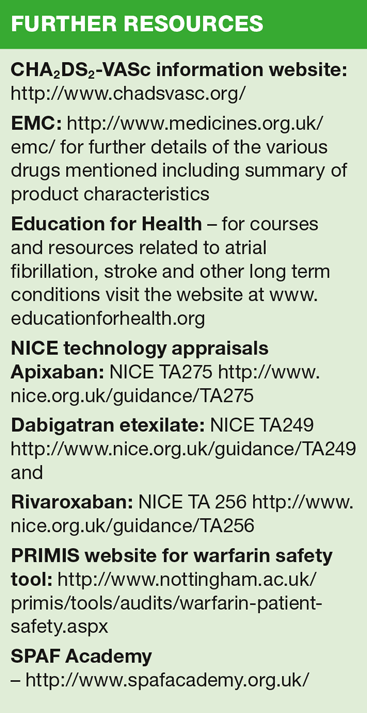Masterclass: Stroke prevention in atrial fibrillation
Beverley Bostock-Cox
Beverley Bostock-Cox
RGN, BSc, MSc
Nurse Practitioner Mann Cottage Surgery Moreton in Marsh
Clinical Lead Education for Health
For many years we have relied on aspirin to reduce the risk of stroke in people with atrial fibrillation, but the recent update to NICE guidance overturns this approach and requires a more detailed knowledge of the options in anticoagulation. Current practice and old ways of thinking may need to be challenged to ensure people are offered the best standard of care
The first update to NICE guidance on the management of atrial fibrillation (AF) in almost a decade reflects the latest evidence and the most recent developments in pharmacological therapies for this condition, paying particular reference to stroke prevention.1 There is a strong focus on the fact that aspirin no longer has a role in stroke prevention along with recognition of the importance of patient choice when it comes to using anticoagulation. General practice nurses (GPNs) have an important role in advising patients about these choices and enabling them to make an informed decision.
By the end of this article you should
- Be aware of the link between atrial fibrillation and stroke
- Understand the new tools recommended for assessing stroke risk and bleeding risk
- Recognise the rationale for stopping aspirin and starting anticoagulation in people with AF in order to reduce stroke risk
- Be able to explain the different modes of action of warfarin and newer oral anticoagulant drugs
- Appreciate the role GPNs have in supporting patients with a diagnosis of AF who require anticoagulation
PREVALENCE AND SIGNIFICANCE OF AF
The prevalence of AF has been shown to approximately double with each decade of age, increasing from 0.5% in people aged 50–59 years to almost 9% for those aged 80–89 years.2 AF is more common in men than in women. The irregular activity of the heart that is a key feature of AF leads to an increased risk of small clots forming which may then be introduced into the brain circulation causing a stroke. People with AF are five times more likely to suffer a stroke.3 In 2012 a report from Action for Stroke Prevention stated that for many people, the first time they will know that they have AF is when they have a stroke. They went on to say that approximately 70% of patients with known AF who had a stroke caused by a blood clot were not receiving anticoagulant therapy.
DIAGNOSING AF
As AF can be asymptomatic, a manual pulse check should be carried out to assess for an irregular pulse, especially in older people where the risk of AF increases. An ECG should be performed in all patients, whether symptomatic or not, if an irregular pulse is identified. The typical features of AF on an ECG include irregularly irregular QRS complexes with a notable absence of P waves.1
ASSESSING STROKE RISK
Many clinicians will be familiar with CHADS2 as the stroke risk calculator tool that has been used for QOF.4 (See Understanding general practice business, page 26). However, the new NICE guidelines recommend using a more specific risk assessment tool CHA2DS2-VASc instead of CHADS2. This is because CHA2DS2-VASc is a more finely tuned risk assessment tool, which is able to identify people who might previously have been assessed as being at low risk but who would actually benefit from anticoagulation. NICE recommends using CHA2DS2-VASc score in anyone with any type of AF, including paroxysmal, persistent or permanent AF and whether they are symptomatic or not. CHA2DS2-VASc can also be used to assess stroke risk in people with atrial flutter. (Table 1)
Risk assessment tools can be useful when weighing up the risk: benefit ratio of anticoagulation. CHA2DS2-VASc will determine the risk of stroke, while the HAS-BLED calculator (see below) can be used to determine the risk of bleeding.5 An overview of the two scores should then be taken in order to decide on the need for treatment. In general, the risk: benefit ratio will discourage the use of anticoagulation in people aged under 65 years who have AF but no other risk factors; this scenario will give men a score of 0 and women a score of 1 and these scores suggest that the individual is at low risk. Unlike CHADS2, CHA2DS2-VASc recognises the increased risk of stroke in women compared with men and therefore any additional risk factor will lead to a score of 2 or more, suggesting that the risk: benefit ratio would favour prescribing it.
Case study
Marianne is 77 years old and was recently taken ill while on holiday with her daughter and son-in-law. After suffering an episode of acute breathlessness and palpitations an electrocardiogram demonstrated the typical features of atrial fibrillation and she was advised to see a cardiologist when she returned home. Marianne’s past medical history includes asthma, hypertension and stable chronic kidney disease stage 3a. Her current medication consists of an inhaled corticosteroid/long acting beta2 agonist inhaler taken twice daily and ramipril 5mg taken once daily.
Based on Marianne’s history, her CHA2DS2-VASc score would be 4, indicating a clear need for anticoagulation.
CALCULATING BLEEDING RISK
The updated NICE AF guideline recommends using the HAS-BLED bleeding risk score to allow stroke risk and bleeding risk to be compared when deciding whether or not to prescribe warfarin or a NOAC. (Table 2) It is important to note, however, that a high risk (score of 3 or more) does not mean that anticoagulation should be withheld but primarily indicates those people who need more careful and regular observation along with consideration of how to reduce increased bleeding risk due to other factors – alcohol or other drugs such as NSAIDs, for example.
It is important to remember that people’s stroke risk can change and that people who have previously been assessed as being at low risk and therefore not requiring anticoagulation may score differently as a result of getting older or developing co-morbidities such as diabetes or heart failure. Similarly bleeding risk may also change and should also be reassessed in the light of new medication or new co-morbidities. A review of stroke risk and bleeding scores may be carried out as part of the annual review.
MANAGING STROKE RISK: ASPIRIN, WARFARIN AND NOACs
There are two major coagulation pathways: the intrinsic pathway and the extrinsic pathway, which both merge into the common pathway. Vitamin K is necessary for the synthesis of many coagulation factors (II, VII, IX and X, as well as protein C and protein S) and warfarin acts as an anticoagulant by blocking the action of Vitamin K and inhibiting coagulation.6 The mode of action of the non-vitamin K oral anticoagulants currently available varies. Dabigatran is a direct thrombin (factor IIa) inhibitor; apixaban and rivaroxaban are both direct factor Xa inhibitors. Factor IIa (thrombin) turns fibrinogen into fibrin and factor Xa turns prothrombin into thrombin. Aspirin is an antiplatelet drug. As previously stated, the 2014 AF guidelines give a strong message about the need to move away from aspirin and towards anticoagulants when managing stroke risk. The reason for this is that while both aspirin and warfarin carry similar risks for bleeding, the protection offered by warfarin in reducing the rate of strokes in patients with AF has been shown to be significantly superior to aspirin or dual antiplatelet therapy.7 In the past, there has been a perception that aspirin is somehow safer than warfarin, especially in older people, but research such as the BAFTA study has demonstrated that this is not true and that offering aspirin instead of warfarin on the fallacious premise that it is safer means that people treated with aspirin are being left at risk.8
However, warfarin also presents some challenges in the management of stroke risk as patients on warfarin must undergo regular monitoring of INR to ensure that this is maintained within the narrow therapeutic window of 2-3, and regular dose adjustments may be necessary in order to ensure achieve this. Warfarin also has several interactions with other drugs and foods which may make this harder to achieve.9 Depending on local referral pathways, patients who are newly diagnosed with AF and who require anticoagulation with warfarin may also suffer delays in starting on treatment leaving them at risk of stroke in the interim period.
Time in therapeutic range (TTR) is an important predictor of the likely benefits of warfarin in stroke prevention and it has been estimated that people on warfarin need to stay within the therapeutic range for at least 65% of the time for those benefits to be realised.1 When calculating TTR, computer-based or manual calculations can be used, excluding any measurements taken during the first 6 weeks of treatment. When assessing control, particular attention should be paid to anyone who, in the past six months, has had two INR readings higher than 5, any INR readings higher than 8 or two INR readings less than 1.5 as all of these indicate poor control. Poor control means that the risk: benefit ratio of warfarin therapy will be adversely affected and consideration should then be given to the introduction of a NOAC.
NOACs currently available include dabigatran, rivaroxaban and apixaban. They have several benefits including a rapid onset (and offset) of action so referral to an anticoagulation clinic is not required and medication can be started immediately in primary care. They also do not require monitoring, have few drug interactions and no food interactions, and therefore may be more convenient in many respects. In terms of their role in reducing stroke risk NOACs have been shown to be at least as effective as warfarin with similar or reduced bleeding risks.10– 13 They are a more expensive option than warfarin, however, even allowing for the cost of INR testing. However, the financial cost of a stroke (not to mention the personal cost to the individual in terms of disability and quality of life) can potentially wipe out savings made by not prescribing a NOAC when indicated, so drug acquisition cost alone should not be the basis for deciding between warfarin and a NOAC. The ultimate decision should be based on the individual circumstances and patient preference.1
PATIENT EDUCATION AND IMPROVING CARE PROVISION
Some people will be anxious at the prospect of starting on anticoagulation and these concerns should be recognised and discussed. Unfortunately, some health care professionals may share their concerns especially around the possibility of an intracerebral haemorrhage (ICH) following a fall. However, calculations based on the risk of ICH and falls have suggested that an individual taking warfarin would need to fall almost every day of the year for this risk to be realised.14 For most people, then, the benefits of anticoagulation in terms of stroke risk reduction outweigh the risk of bleeding.
Measuring and managing stroke risk in people with AF will require a concerted effort from all members of the primary care team. Current practice and old ways of thinking may need to be challenged to ensure people are offered the best standard of care. The University of Nottingham’s PRIMIS service (http://www.nottingham.ac.uk/primis/index.aspx) offers support to practices in this respect through GRASP-AF which systematically identifies patients who are on warfarin, assesses their TTRs and out of range INR results and calculates the HAS-BLED scores. This allows patients who are at risk of stroke due to unacceptable INR results to be identified. An individual case review can then be carried out to determine whether a change of therapy might be indicated. The service is free and is fully supported by the NHS. Other suggested activities aimed at recognising the new guidelines and improving standards of care might be to discuss the new guidelines at a practice meeting to ensure that everyone is aware of current best practice.
SUMMARY
The updated NICE guidelines offer a clear rationale for reviewing the way in which stroke risk is addressed in people with a diagnosis of AF. This means that practices should now take the opportunity to identify patients who may need a review of current treatments strategies. For those who are diagnosed with AF from now on, there should be no doubt about how to proceed and the focus should be on getting treatment right from the start. For those who have been diagnosed with AF previously and who are being sub-optimally treated with aspirin, the opportunity can be taken to review stroke risk using CHA2DS2-VASc and bleeding scores with HAS-BLED. At each review a decision can be made regarding treatment of stroke risk recognising that aspirin no longer has a place in reducing risk and that warfarin or the NOACs should be offered instead. Clinicians should be able to confidently and competently explain the rationale for this in order to support patients at this time.
REFERENCES
1. NICE (2014) AF guidelines Available from www.nice.org.uk/Guidance/CG180. Accessed September 2014
2. Go AS, Hylek EM, Phillips KA, et al. Prevalence of diagnosed atrial fibrillation in adults: national implications for rhythm management and stroke prevention: the AnTicoagulation and Risk Factors in Atrial Fibrillation (ATRIA) Study. JAMA 2001 ;285(18): 2370-5
3. Atrial Fibrillation Association. AF : preventing a stroke crisis, 2011. http://www.preventaf-strokecrisis.org/report/report-summary/
4. Gage BF, Waterman AD, Shannon W, et al. Validation of clinical classification schemes for predicting stroke: results from the National Registry of Atrial Fibrillation. JAMA 2001; 285: 2864–70
5. Pisters R, Lane DA, Nieuwlaat R, et al. A novel user-friendly score (HAS-BLED) to assess 1-year risk of major bleeding in patients with atrial fibrillation: the Euro Heart Survey. Chest 2010 Nov;138(5):1093-100
6. Moore G, Knight G, Blann A. Haematology. OUP; Oxford: 2010
7. Hart RG, Pearce LA, Aquilar MI. Meta-analysis: antithrombotic therapy to prevent stroke in patients who have nonvalvular atrial fibrillation. Ann Intern Med 2007;146:857–67.
8. Mant J, Hobbs FD, Fletcher K, et al. Warfarin versus aspirin for stroke prevention in an elderly community population with atrial fibrillation (the Birmingham Atrial Fibrillation Treatment of the Aged Study, BAFTA): a randomised controlled trial. Lancet 2007;370:493–550.
9. Anticoagulation Europe UK. Warfarin interactions, 2012. http://www.anticoagulationeurope.org/publications/common-interactions-with-warfarin
10. Connolly SJ, Ezekowitz MD, Yusuf S, et al. Dabigratran versus warfarin in patients with atrial fibrillation. NEJM 2009;361:1139–51
11. Connolly SJ, Ezekowitz MD, Yusuf S, et al. Newly identified events in the RE-LY trial. NEJM 2010;363:1875–6
12. Granger CB, Alexander JH, McMurray JJ, et al. Apixaban versus warfarin in patients with atrial fibrillation. NEJM 2011;365:981-92.
13. Patel MR, Mahaffey KW, Garg J et al. Rivaroxaban versus warfarin in nonvalvular atrial fibrillation. NEJM 2011;365:883–91
14. European Society for Cardiology. Guidelines for the management of atrial fibrillation. European Heart Journal 2010 31:2369–2429.
Related articles
View all Articles


